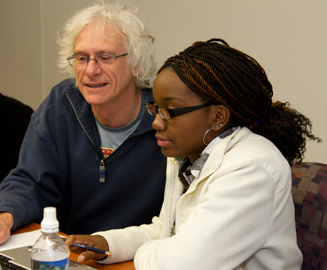The right chemistry
Graduate course blends videoconferencing, in-person visits
May 6, 2011 - by Staff
May 6, 2011 - by Staff
6 May 2011 • A group of five master’s and doctoral students broke new ground this semester as they learned from top researchers halfway across the United States. As part of a new graduate course in atmospheric chemistry, students from North Carolina Agricultural and Technical State University connected with more than a dozen NCAR scientists through video lectures and a weeklong visit to Boulder.
The course emerged through a 2009 memorandum of understanding between NSF and the Interdisciplinary Scientific Environmental Technology Cooperative Science Center (ISET-CSC), one of five NOAA-based CSCs that partners with minority-serving institutions to develop modeling, sensing, and information analysis tools. Based at North Carolina A&T, an historically black institution located in Greensboro, ISET-CSC collaborates with six other colleges and universities from Alaska to Georgia.

As part of a modeling exercise, NCAR’s Geoff Tyndall confers with Stephany Taylor, now in her first year of graduate work in energy and environmental sciences at North Carolina A&T. (© UCAR. This image is freely available for media and nonprofit use.)
The seeds of the course were planted when Geoff Tyndall, from NCAR’s Atmospheric Chemistry Division (ACD), went to A&T last year to give a seminar. From that visit, and similar visits by other NCAR scientists, emerged an informal collaboration leading to the course, which was developed jointly by ACD scientists and ISET-CSC director Solomon Bililign.
Tyndall taught one of the six two-hour lectures, which were delivered via videoconference from Boulder to Greensboro on most Tuesdays during January and February. “We always had scientists in the room, so there was a bit of an audience on our end too,” says Tyndall. “The technology worked remarkably well—I was pleasantly surprised.”
The students then spent the week of 7–11 March at NCAR, taking part in modeling and laboratory exercises, lectures, and facility tours. Course material ranged from the fundamentals of gas-phase and heterogeneous processes to air quality, chemistry and climate, and approaches to measuring and modeling.
“We’ve taught a number of classes before, but this was a unique format,” says ACD’s Sasha Madronich. “The videoconferencing is certainly accessible and inexpensive. It still doesn’t have the same personal interaction that an onsite visit has, of course, so the two parts are both very important.”
The course brought a variety of benefits to participants, who themselves straddled a variety of points along the grad-school pathway. Now in the second year of a master’s program in chemistry, Ndifreke Amama is writing a thesis on how lightning may contribute to the formation of tropospheric ozone along the coast of South America. From this semester’s course, he says, “I’ve gotten a lot of background information on nitrogen oxides as a precursor to ozone formation.”
“There were a few gaps in my education that the professors at A&T didn’t have the background to fully explain for a clear understanding,” says Darkus Jenkins, now in her fourth year of a doctoral degree in energy and environmental systems. She’s working on developing photoluminescent sensors for volatile organic compounds.
Another student closing in on his Ph.D., Anthony Cochran, came into the energy and environmental systems program at A&T by way of physics. “I’m not a chemist,” says Cochran, “so this would have been a great course to have when I first came in. But now it’s perfect for preparing for my dissertation.”